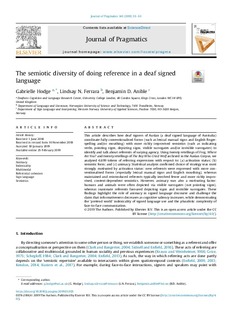| dc.contributor.author | Hodge, Gabrielle | |
| dc.contributor.author | Ferrara, Lindsay Nicole | |
| dc.contributor.author | Anible, Benjamin Donald | |
| dc.date.accessioned | 2019-08-13T07:10:07Z | |
| dc.date.available | 2019-08-13T07:10:07Z | |
| dc.date.created | 2019-02-05T14:26:28Z | |
| dc.date.issued | 2019 | |
| dc.identifier.citation | Journal of Pragmatics. 2019, 143 33-53. | nb_NO |
| dc.identifier.issn | 0378-2166 | |
| dc.identifier.uri | http://hdl.handle.net/11250/2608008 | |
| dc.description.abstract | This article describes how deaf signers of Auslan (a deaf signed language of Australia) coordinate fully conventionalised forms (such as lexical manual signs and English fingerspelling and/or mouthing) with more richly improvised semiotics (such as indicating verbs, pointing signs, depicting signs, visible surrogates and/or invisible surrogates) to identify and talk about referents of varying agency. Using twenty retellings of Frog, Where Are You? and twenty retellings of The Boy Who Cried Wolf archived in the Auslan Corpus, we analysed 4,699 tokens of referring expressions with respect to: (a) activation status; (b) semiotic form; and (c) animacy. Statistical analysis confirmed choice of strategy was most strongly motivated by activation status: new referents were expressed with more conventionalised forms (especially lexical manual signs and English mouthing), whereas maintained and reintroduced referents typically involved fewer and more richly improvised, context-dependent semiotics. However, animacy was also a motivating factor: humans and animals were often depicted via visible surrogates (not pointing signs), whereas inanimate objects favoured depicting signs and invisible surrogates. These findings highlight the role of animacy in signed language discourse and challenge the claim that informativeness decreases as cognitive saliency increases, while demonstrating the ‘pretend world’ indexicality of signed language use and the pluralistic complexity of face-to-face communication. Key words: animacy, indexicality, multimodal, referential cohesion, sign language, semiotics | nb_NO |
| dc.language.iso | eng | nb_NO |
| dc.publisher | Elsevier | nb_NO |
| dc.relation.uri | osf.io/jctp4 | |
| dc.rights | Navngivelse 4.0 Internasjonal | * |
| dc.rights.uri | http://creativecommons.org/licenses/by/4.0/deed.no | * |
| dc.subject | Tegnspråklingvistikk | nb_NO |
| dc.subject | Linguistics of sign language | nb_NO |
| dc.subject | Pragmatikk | nb_NO |
| dc.subject | Pragmatics | nb_NO |
| dc.title | The semiotic diversity of doing reference in a deaf signed language | nb_NO |
| dc.type | Journal article | nb_NO |
| dc.type | Peer reviewed | nb_NO |
| dc.description.version | publishedVersion | nb_NO |
| dc.source.pagenumber | 33-53 | nb_NO |
| dc.source.volume | 143 | nb_NO |
| dc.source.journal | Journal of Pragmatics | nb_NO |
| dc.identifier.doi | 10.1016/j.pragma.2019.01.025 | |
| dc.identifier.cristin | 1673678 | |
| dc.description.localcode | © 2019 The Authors. Published by Elsevier B.V. This is an open access article under the CC BY license (http://creativecommons.org/licenses/by/4.0/). | nb_NO |
| cristin.unitcode | 194,62,60,0 | |
| cristin.unitname | Institutt for språk og litteratur | |
| cristin.ispublished | true | |
| cristin.fulltext | original | |
| cristin.qualitycode | 2 | |

